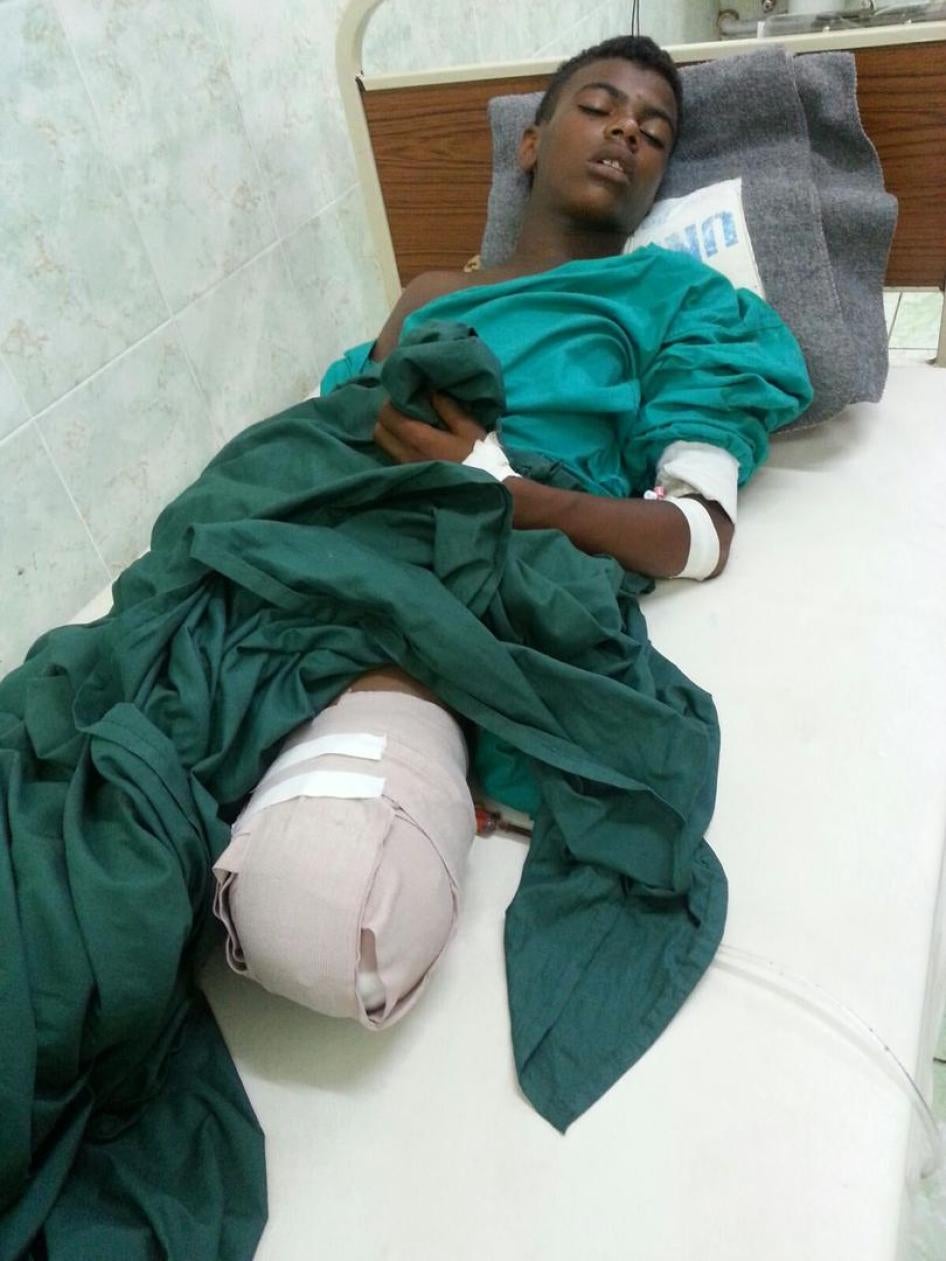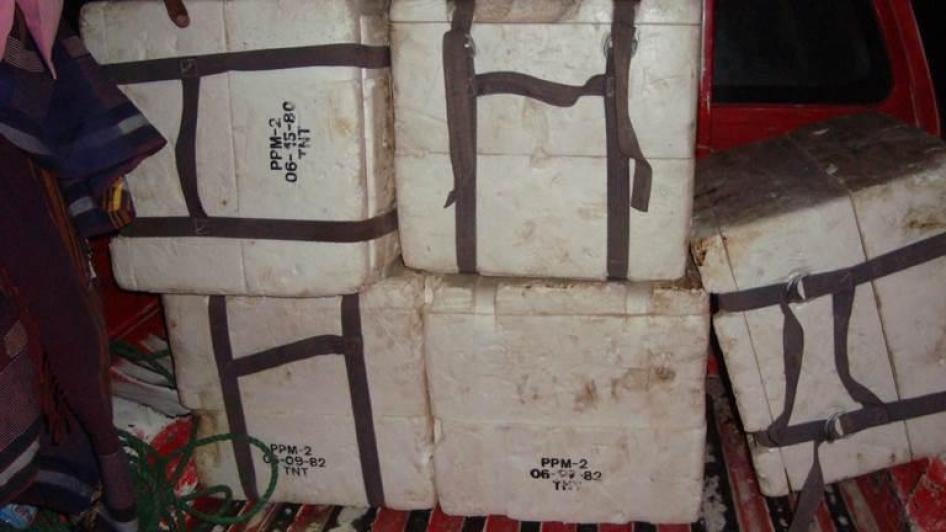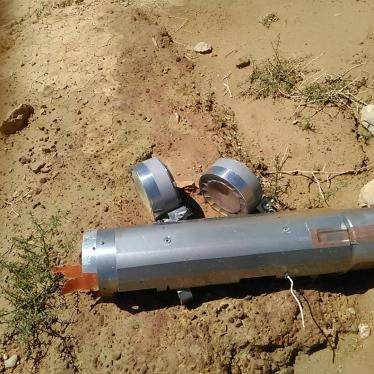(Beirut) – Houthi forces in Yemen are using banned antipersonnel landmines, causing multiple new civilian casualties, Human Rights Watch said today, releasing new evidence of their use. The Houthis, also known as Ansar Allah, should cease using these weapons.
Landmines have killed at least 12 people and wounded over 9 in Yemen’s southern and eastern governorates of Abyan, Aden, Marib, Lahj, and Taizz since September 2015, according to Yemeni mine clearance officials, medical professionals, and media reports. Antivehicle mines accounted for 9 of those killed and 5 injured, although whether the mine is antivehicle or antipersonnel is often not detailed in reporting. Human Rights Watch believes that the actual number of mine victims in Yemen since September may be much higher.
“The Houthis are killing and maiming civilians with landmines,” said Steve Goose, arms director at Human Rights Watch. “Antipersonnel landmines are indiscriminate weapons that should not be used under any circumstances. Houthi forces should immediately stop using these horrific weapons and respect Yemen’s obligations under the Mine Ban Treaty.”
The United Nations Human Rights Council should create an independent international commission of inquiry to investigate these and other serious laws-of-war violations by all parties to Yemen’s conflict, Human Rights Watch said.
There were numerous casualties from landmines laid by Houthi forces before their retreat from Abyan and Aden in July, Human Rights Watch said.
Yemen ratified the 1997 Mine Ban Treaty on September 1, 1998, making a commitment to never use antipersonnel mines under any circumstances, and to prevent and suppress the activities prohibited by the treaty. A total of 162 countries are party to the treaty, which comprehensively prohibits the use, production, transfer, and stockpiling of antipersonnel mines and requires their clearance and assistance to victims.
Mine clearance personnel have found at least two types of blast antipersonnel mines produced in the 1980s: PPM-2 mines manufactured in the former East Germany and GYATA-64 mines made in Hungary. In April 2002, Yemen reported to the UN that it had finished destroying its stockpile of antipersonnel mines as required by the Mine Ban Treaty. Neither mine was among the four types of antipersonnel mines that Yemen has reported stockpiling in the past, including for training mine clearance personnel.
Both the PPM-2 and GYATA-64 mines have been used elsewhere in Yemen in recent years. The evidence of further use of these antipersonnel mines in 2015 suggests either that the 2002 declaration to the UN secretary-general on the completion of landmine stockpile destruction was incorrect, or that these mines were acquired from another source after 2002.
It is unlikely that the PPM-2 or GYATA-64 antipersonnel mines found in Yemen were manufactured recently, as both Germany and Hungary signed the Mine Ban Treaty in December 1997, committing to end production and transfers of antipersonnel mines. Styrofoam crates of PPM-2 antipersonnel mines found by deminers in Bab al-Mandeb in October 2015 also contained packaging dated June 17, 1981, while the crate exteriors were marked with various dates in 1980 and 1982.
Houthi forces also appear to have used antivehicle mines manufactured in the former Soviet Union, including TM-62 and TM-57 mines, as well as UKA-63 antivehicle mines manufactured in Hungary.
Victim-activated improvised explosive devices (IEDs) that explode due to the presence, proximity, or contact of a person fall under the definition of an antipersonnel landmine and are prohibited by the Mine Ban Treaty. Deminers have found and cleared victim-activated IEDs from Aden and elsewhere in southern Yemen in 2015. In 2013, the Yemeni government accused Houthi forces of using victim-activated IEDs in 2011-2012 in Saada and Haijja governorates during fighting with local Sunni tribes backed by the government.
There has been no evidence to suggest that members of the Saudi Arabia-led coalition have used landmines in their military operations in Yemen.
International assistance is urgently needed to equip and assist clearance personnel to systematically survey and clear mines and explosive remnants of war from areas that have recently experienced fighting, Human Rights Watch said. Appropriate compensation, assistance, and support should be provided to those injured as a result from the mines and to the families of those injured or killed, as well as to other landmine victims in Yemen, including medical care and rehabilitation.
The United Arab Emirates (UAE) has apparently deployed mine clearance vehicles to assist in clearance operations in Aden and Marib. Saudi-coalition forces have also been photographed apparently clearing mines in Marib.
The national Yemen Executive Mine Action Center (YEMAC) sometimes has to convince armed groups and civilians to turn in landmines in their possession to mine action teams for destruction. Some refuse to hand them over without payment or compensation. Possession of antipersonnel mines by civilians or armed groups in Yemen is a violation of the Mine Ban Treaty and Yemen’s 2005 implementing legislation for the treaty.
Human Rights Watch is a founding member of the International Campaign to Ban Landmines, which received the 1997 Nobel Peace Prize for its efforts to bring about the Mine Ban Treaty and for its contributions to a new international diplomacy based on humanitarian imperatives.
Details regarding recent landmine incidents:
Aden Governorate
Yemeni mine clearance officials told Human Rights Watch that:
- On September 14, 2015, a PPM-2 antipersonnel mine was cleared from under a tree near al-Nasr Camp in Khormaksar next to Aden International Airport. It had apparently been laid to harm people taking shelter in the shade of the tree.
- On October 12, Wa’el Khaled Muhammad al-Ruja`a, 15, lost his left leg when a landmine exploded as he walked with his friends on the coastal road around the perimeter of Aden Airport, a walk they had taken often. He slipped off the road toward the sea and stepped on a mine. His friends were slightly injured.
A mine action official told Human Rights Watch that mines and explosive remnants of war have been cleared from former battle areas surrounding the entrance to Aden governorate, where Houthi forces were stopped in their approach to capture Aden. At the end of September, YEMAC officials said that people cannot drive safely outside of asphalt roads. The official listed more than a dozen major roads that are suspected to be mine-affected areas.
Mine action officials said that their vehicles, protective equipment, and supplies were all looted during the fighting in Aden.
In 2009, Yemen declared the completion of mine clearance in Aden and had returned the formerly mine-affected areas to communities for productive use.
Marib Governorate
Multiple victims have been killed or wounded by landmines in Marib governorate, east of the capital, Sanaa, in the center of the country, since Houthi fighters withdrew in early October.
On November 4, Abd al-Aziz al-Shadadi, 36, the health director in Marib, told Human Rights Watch that 48 people have died and 66 have been injured in landmine-related incidents since March, when the Saudi-led coalition began its military campaign in Yemen. He said the mine victims include children and women. Some have been taken abroad for treatment as local medical facilities cannot treat complex landmine injuries. “We are running low on our medical supplies in the hospital and because of the war all the expert doctors who used to help us with landmine injuries left the country,” al-Shadadi said.
Ali al-Tam, a medical professional, told Human Rights Watch in early November that he had treated 12 landmine victims, of whom 6 died at a hospital in Marib. He provided Human Rights Watch with a list of victims treated from the following incidents:
- On October 10, a man was treated for fragmentation wounds to his face from an apparent landmine explosion;
- On October 13, four men from the same family died and another civilian traveling with them was injured when their vehicle hit an antivehicle mine in al-Faw in southwest Marib governorate;
- On October 18, a man was injured by a landmine;
- On October 21, a man was injured by a landmine;
- On October 22, a 26-year-old man was killed in a landmine explosion at his farm; and
- On October 28, a 25-year-old man died and two men ages 18 and 20 were seriously injured when an antivehicle mine destroyed the car they were driving off-road.
Al-Tam said, “Landmines are like a ghost of death, doesn’t matter who laid them,” Adding that the areas of al-Jafina, al-Faw, al-Maneen, Khat al-Saad, al-Blaq, Thabat al-Masariah, al-Mashajaa, al-Thaba al-Hamara, and Kofal are mined.
Al-Tam said that the casualties were all from landmines laid in areas occupied by Houthi fighters until their retreat from Marib in early October. Marib, he said, was not known to have a significant landmine problem prior to 2015.
The health department and governor’s office were cooperating to compensate individuals who collect landmines and turn them in to local authorities as part of an effort to prevent the spread of weapons, al-Tam said.
Abyan and Lahj Governorates
There were also new landmine victims in Abyan and Lahj governorates. A mine action official told Human Rights Watch:
- In late September, two civilians were killed in Lahj’s Saber neighborhood by an antivehicle mine on the road from Saber to al-Waht near Saber Education College;
- On November 2, two civilians were injured by an antivehicle mine in Khanfer district in Abyan governorate; and
- On November 2, Ziad Faisal al-Naseri and his friend Sharaf Mahfood, both children, were killed by a mine in al-Hotah, the capital of Lahj governorate.
According to a mine official, the mine action teams had cleared a total of 2,564 landmines and explosive remnants of war from Lahj governorate as of September 27.
Taizz Governorate
Houthi fighters left mines as they retreated from the Red Sea coastal passage of the Taizz governorate, news media reported. They retreated as pro-government forces – backed by coalition forces from the UAE and Saudi Arabia – helped armed “local popular committees” opposed to the Houthis in Taizz regain control of areas leading to the Bab al-Mandeb strait, along with Mayoun Island. As of October 19, mine action officials reported the clearance of 228 antipersonnel mines and 930 antivehicle mines from Bab al-Mandeb, and 237 antipersonnel mines and 272 antivehicle mines from Mayoun Island.
A mine action official told Human Rights Watch that Houthi forces also abandoned antipersonnel mines as they retreated from Bab al-Mandeb. One photograph taken by mine action officials shows five Styrofoam crates found at former Houthi positions, which they said contained unused PPM-2 antipersonnel landmines. The markings indicate the type of mine and its date of manufacture and/or packing of June 15, 1980.
A UAE media report on November 2 said that two people were killed in an antivehicle mine explosion in the Tha’abat area of Taizz city, where UAE units from the coalition and pro-government forces have been attempting to regain control of the city from Houthi forces. The incident occurred on a major road that connects the roundabout of the Republican palace with the center of Taizz city. A local fighter allied with the coalition forces told media that they closed the road after the incident because it was “full of landmines.” He described the planting of landmines by Houthi forces as evidence that they would be withdrawing from the area because they have heavily mined other battle fronts in Yemen just before retreating.















